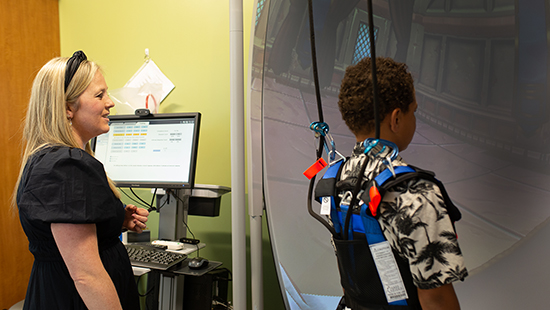Virtual Reality Balance System Gets Kids Moving

When a child or teen has a problem with balance, due to a traumatic brain injury, a concussion, or any one of dozens of other conditions that can affect the body's vestibular system, restoring that balance is a key part of the rehabilitation process. Sophisticated technology can help kids make progress in a safe environment. This year, MWPH acquired the Bertec Balance System, a state-of-the-art machine that uses virtual reality to simulate a variety of situations.
"There aren't a lot of pediatric rehabilitation facilities that have the Bertec," said Julie Quinn, PT, MSEd, PCS, director of rehabilitation at MWPH. "It uses a form of virtual reality so that when you're in the dome, you feel as though you are really moving."
Simulating Everyday Movements Safely
The system simulates walking through a park, browsing in the grocery store and a variety of other activities. It provides the sensory information and visual input a child would encounter while walking down a school hallway, for example. "Our brains are constantly assimilating many types of information as we're navigating any environment, and the Bertec is able to recreate that experience," Quinn said.
All the while, there is a force plate in the bottom of the system that is measuring how the child's body is moving in space. This gives the rehabilitation team key information to assess the child's progress toward recovery.
The system can incorporate evaluations of sensory, visual and cognitive processing speeds. "We can show signs, letters, or even math problems in the periphery for just a moment, to assess whether the child is processing that information," Quinn said.
Customizable for Many Types of Conditions
The system can also be customized with variables, including whether the child needs to shift weight, how much stimuli is in the environment, how fast things are moving, how bright the light is and more. It can be customized for any age and all types of brain injury and balance issues.
The Bertec also has robust capability to assess how a child's eyes are working and reacting, including depth perception and focus ability. If any problems are detected, it provides a report with detailed information that can help the team refer the child to an appropriate specialist.
The reporting ability might be the most helpful of all the Bertec's innovations. "It enables us to give patients and families more specific information about their skills, to help us determine when kids are ready for school," Quinn said. "It's a leap forward for MWPH."
